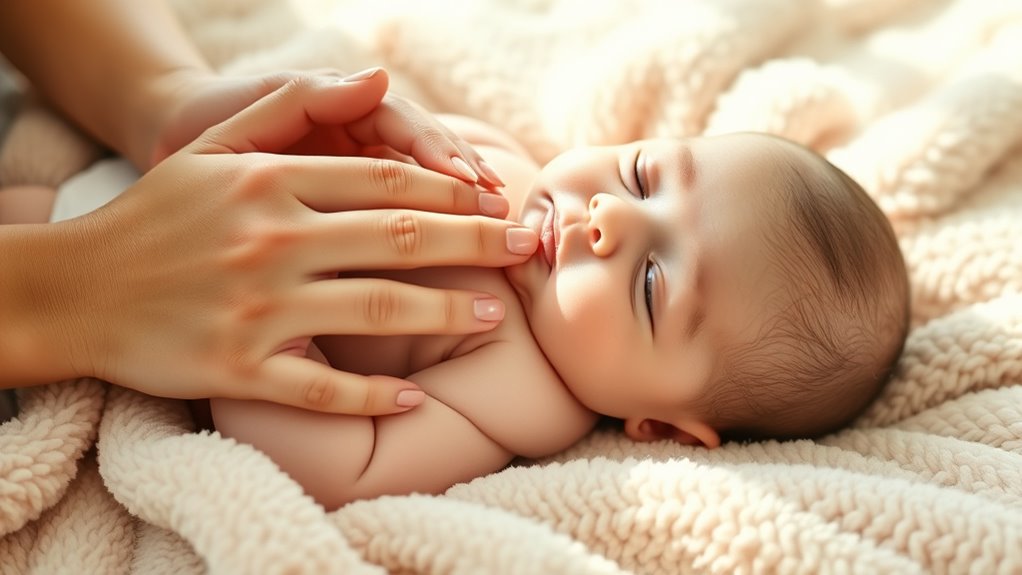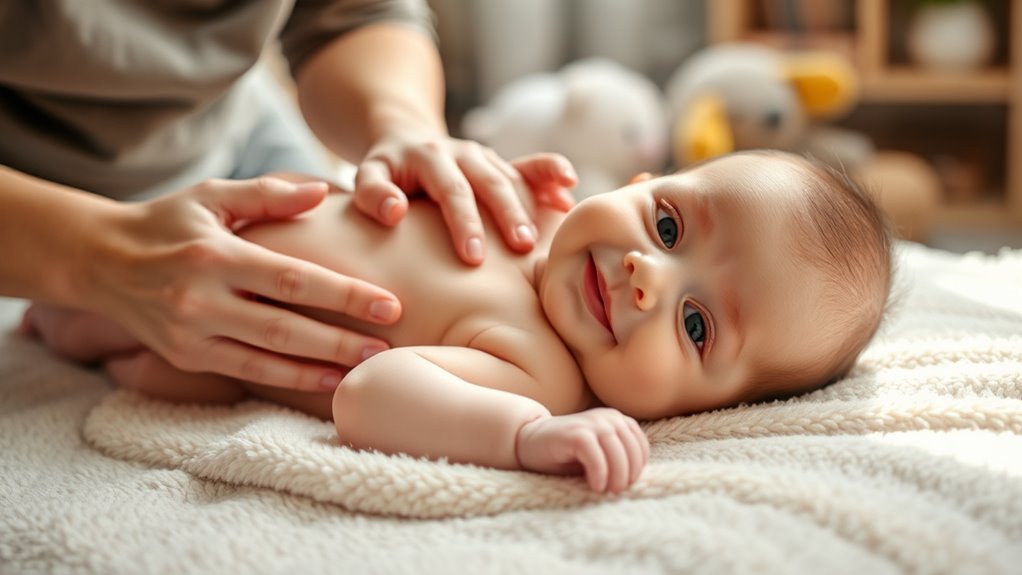Infant massage offers many benefits, such as promoting relaxation, improving sleep, boosting circulation, and strengthening your bond. It also supports your baby’s physical development and emotional security. To guarantee a safe experience, pay attention to signs of readiness, keep the environment warm and calm, and use gentle, appropriate techniques. By following essential precautions, you create a positive routine that nurtures your baby’s growth. Keep exploring to learn how to make the most of this caring practice.
Key Takeaways
- Infant massage promotes bonding, relaxation, and emotional security while supporting sleep, immune health, and overall well-being.
- It encourages physical growth, motor skills, and early detection of developmental delays.
- Observe baby’s cues to ensure readiness, comfort, and avoid overstimulation or distress during massage.
- Use gentle techniques, proper tools, and a safe environment, consulting a pediatrician before starting.
- Monitor for signs of discomfort, stop if baby shows fussiness or pain, and follow safety precautions to ensure a positive experience.
Understanding the Advantages of Infant Massage

Understanding the advantages of infant massage reveals how this simple practice can benefit your baby’s development and well-being. When you massage your baby, you promote relaxation, reduce fussiness, and strengthen your bond. The gentle touch stimulates nerve endings, helping your baby feel secure and comforted. It also encourages better sleep patterns, making your little one more rested and alert during the day. Plus, infant massage can boost circulation and support the immune system, helping your baby stay healthier. As you learn to read your baby’s cues, you’ll deepen your understanding of their needs. This routine not only nurtures their physical health but also fosters emotional security, creating a foundation of trust and connection that benefits both of you in the long run. Additionally, incorporating proper technique ensures that your massage is safe and effective for your little one.
How Infant Massage Supports Physical Development

Infant massage plays a vital role in supporting your baby’s physical development by encouraging muscle growth, coordination, and motor skills. As you gently massage your baby, you help strengthen their muscles and improve their body awareness. This physical stimulation promotes better control over movements, helping develop skills like reaching, grasping, and crawling. Regular massage can also enhance circulation, which supports overall growth and tissue health. By engaging in this nurturing activity, you give your baby opportunities to practice movement patterns in a safe, soothing environment. Incorporating consistent massage sessions can also facilitate early detection of developmental delays, allowing for timely intervention and support. Over time, these practices can lead to increased strength and flexibility, laying a solid foundation for future motor milestones. Overall, massage is a simple yet effective way to foster your baby’s physical growth and coordination.
The Psychological Benefits for Your Baby and You

When you massage your baby, you strengthen your bond and build trust between you. This connection helps reduce their stress and anxiety, making them feel more secure. As a result, both you and your baby enjoy greater emotional stability and reassurance. Incorporating infant massage can also support your baby’s emotional development, fostering a sense of safety and comfort.
Enhances Bonding and Trust
Engaging in regular infant massage can substantially strengthen the emotional bond between you and your baby. When you touch and interact through massage, you create a sense of security and comfort that helps your baby feel loved and valued. This physical closeness fosters trust, making your baby more receptive to your care and guidance. As you synchronize your movements with your baby’s responses, you build a mutual understanding that deepens your connection. The calming, attentive environment encourages your baby to associate your touch with safety and affection. Additionally, incorporating essential oils in your massage routine can enhance relaxation and emotional well-being for your baby. Over time, this nurturing routine enhances emotional security, helping your baby develop a strong foundation of trust and attachment that benefits their overall well-being and your relationship.
Reduces Stress and Anxiety
Regular infant massage can markedly lower your baby’s stress levels by promoting relaxation and calming their nervous system. When you gently massage your baby, you help reduce the production of stress hormones like cortisol, which often make babies appear fussy or unsettled. This calming touch encourages your baby to feel safe and secure, easing feelings of anxiety. As their body relaxes, their heart rate stabilizes, and breathing becomes more regular. These physiological responses diminish discomfort and promote overall well-being. For you, the act of massaging provides reassurance and a sense of connection, helping you stay present and attuned to your baby’s needs. Incorporating stress hormone management techniques like infant massage can enhance the benefits for your baby’s emotional health. Over time, this routine can create a more peaceful environment, reducing both your baby’s and your own stress levels.
Boosts Emotional Security
Because infant massage fosters close physical contact, it substantially enhances your baby’s sense of emotional security. When you gently massage your baby, you create a calming environment that reassures them they are safe and loved. This tactile connection helps your baby develop trust and a strong bond with you, making them feel more secure as they explore the world. As you consistently engage in massage, your baby learns to associate touch with comfort and care, reducing fussiness and crying. For you, this shared experience deepens your emotional connection, fostering confidence as a parent. Over time, this secure attachment supports your baby’s social and emotional development, laying the foundation for healthy relationships and resilience in the future. Incorporating gentle touch into your routine not only benefits your baby’s emotional well-being but also promotes overall growth and health.
Recognizing the Right Time to Start Massaging

You should start massaging your baby when they’re old enough, typically around a few weeks, but always verify their individual development. Look for signs of readiness, like alertness and comfort, to guarantee they enjoy the experience. Before beginning, consult your pediatrician to confirm it’s the right time and safe for your little one. Recognizing the appropriate age for infant massage helps ensure your baby’s safety and comfort.
Baby’s Age Suitability
Determining the right time to start infant massage depends largely on your baby’s developmental stage and health. Most experts recommend beginning massage after your baby’s umbilical cord has fallen off and the healing process is complete, usually around 2-3 weeks old. At this stage, your baby is typically strong enough to handle gentle touch without discomfort. It’s important to make certain your baby is alert, feeding well, and shows no signs of illness or distress. Avoid massage if your baby has a fever, rash, or other health issues. Starting too early may cause discomfort or interfere with healing. Always consult your pediatrician before beginning infant massage, especially if your baby was born prematurely or has underlying health concerns. Additionally, ensuring the use of vetted baby products can help keep your massage experience safe and effective.
Signs of Readiness
One of the clearest signs your baby is ready for massage is when they appear alert and engaged during wakeful periods. If your little one makes eye contact, responds to your voice, or seems curious about their surroundings, it’s a good indication they’re receptive. Gentle movements or touching seem to soothe or excite them, rather than cause fussiness. Look for consistent alertness, not just brief moments of wakefulness. Additionally, if your baby has a regular feeding and sleeping pattern, they’re more likely to be in a calm state suitable for massage. Avoid trying when your baby is overly tired, hungry, or irritable, as these signs suggest they may not be ready or comfortable for massage at that moment. Recognizing baby readiness cues can help you determine the best time to introduce massage sessions.
Pediatrician Consultation
Before starting infant massage, it’s wise to consult your pediatrician to guarantee your baby is ready. Your doctor can confirm if your baby’s health and developmental stage are suitable for massage. They can also provide specific guidance based on your baby’s needs.
Ask your pediatrician about:
- Any health issues or conditions that might affect massage safety
- The ideal age to begin, especially if your baby was premature
- Signs of discomfort or distress during massage
- Recommended techniques and duration for your baby’s age
This consultation ensures you’re making safe, informed choices. It also helps you understand any precautions to take, so your massage sessions are beneficial and comfortable for your little one.
Essential Tools and Preparations for Safe Massage

To guarantee a safe and comfortable massage for your infant, gathering the right tools and making proper preparations is essential. Start by choosing a warm, quiet space free of distractions. Use a soft, clean towel or blanket to lay your baby on, ensuring comfort and hygiene. Have a gentle, natural oil or lotion ready—avoid fragrances or harsh chemicals—and test a small amount on your baby’s skin first. Keep your hands clean and warm to prevent startling your infant. Use a mirror or soft lighting to create a calming environment. Ensure the room temperature is comfortable to prevent your baby from getting cold. Consider using a safe and suitable oil that is gentle on your baby’s delicate skin to enhance the massage experience. Having these tools and preparations in place helps promote a soothing experience while prioritizing your infant’s safety and comfort.
Step-by-Step Guide to Proper Infant Massage Techniques

Begin by gently supporting your baby’s head and neck with your hands, then use soft, slow strokes to massage each area. Start with the chest, using gentle upward strokes. Move to the arms and legs, applying light pressure and using circular motions. Don’t forget the tummy; massage clockwise to promote digestion. Finish with the back, supporting your baby’s chest and hips as you glide your hands downward.
Follow these steps for an effective massage:
- Cover the main muscle groups with gentle strokes.
- Use your palms rather than fingertips for broader contact.
- Maintain a calm, steady rhythm to soothe your baby.
- Pay attention to your baby’s cues and adjust pressure accordingly.
Always keep your movements gentle and responsive to your baby’s comfort.
Signs of Readiness and When to Pause or Stop

Recognizing your baby’s signs of readiness guarantees that massage sessions are both enjoyable and safe. Look for cues like relaxed body language, calm breathing, and open hands, indicating they’re comfortable. If your baby shows signs of fussiness, turning away, or crying, it’s best to pause the massage and try again later. Watch for signs of overstimulation, such as yawning or rubbing eyes, which signal it’s time to stop. If your baby becomes tense, pulls away, or shows any distress, gently end the session immediately. Remember, every baby is different—pay close attention to their responses. When you notice signs of tiredness or discomfort, it’s a good moment to pause or conclude the massage to keep the experience positive.
Common Mistakes to Avoid During Infant Massage

Avoiding common mistakes during infant massage helps guarantee the experience remains safe and enjoyable for your baby. First, avoid applying too much pressure; gentle strokes are all you need. Second, don’t rush through the massage; give your baby enough time to relax and respond. Third, steer clear of massaging areas that are sore, injured, or sensitive unless directed by a healthcare professional. Fourth, make sure your hands are warm and your environment is comfortable to prevent startling your baby. By paying attention to these points, you create a positive, safe experience that promotes bonding and relaxation. Remember, patience and attentiveness are key to making infant massage beneficial and enjoyable for both of you.
Precautions and Safety Tips for a Positive Experience

To guarantee a positive and safe infant massage experience, it’s essential to follow key precautions and safety tips. Always ensure your hands are clean and warm before beginning, as cold hands can startle your baby. Choose a quiet, comfortable space free of distractions and hazards. Use gentle, moderate pressure; avoid pressing too hard, especially over soft spots or fontanels. Observe your baby’s cues—if they seem uncomfortable or fussy, pause and check for any signs of distress. Never massage over irritated, broken, or infected skin. Keep the room at a comfortable temperature to prevent your baby from getting cold. Be mindful of your baby’s health conditions—if uncertain, consult your pediatrician beforehand. Following these precautions helps make massage a safe, soothing experience for both of you.
Integrating Infant Massage Into Your Daily Routine

Incorporating infant massage into your daily routine can strengthen your bond and promote your baby’s well-being. Consistency is key, so choose a specific time each day, like after a bath or before bedtime. To make it easier, follow these tips:
- Create a calm environment with soft lighting and gentle music.
- Use warm, natural oils to keep your baby comfortable.
- Keep your movements slow and gentle, paying attention to your baby’s cues.
- Incorporate massage into everyday activities, like diaper changes or feeding times, to make it part of your routine.
Frequently Asked Questions
Can Infant Massage Be Used to Soothe Colic or Digestive Issues?
You might wonder if infant massage helps with colic or digestive issues. It can be effective, as gentle strokes on your baby’s tummy may relieve gas and promote digestion. By applying soft, circular motions, you help soothe discomfort and calm your little one. Just remember, always pay attention to your baby’s signals and consult your pediatrician if symptoms persist or worsen to guarantee safety.
Are There Specific Massage Techniques for Premature or Low-Birth-Weight Babies?
You might think all babies get the same massage, but premature or low-birth-weight babies need special care. You’ll want to use gentle, slow strokes, focusing on their tiny limbs and delicate areas. It’s like handling a fragile glass sculpture—every touch counts. Always consult a pediatrician first, and adapt your technique to their unique needs. Remember, patience and softness are your best tools for helping these little miracles thrive.
How Do I Know if My Baby Dislikes Certain Massage Strokes?
If you notice your baby fusses, pulls away, or becomes tense during certain strokes, they might dislike those techniques. Watch for signs like crying, arching their back, or turning their head away. Pay close attention to their cues and adjust your pressure or move to different strokes. Always respect their reactions, and if they seem distressed, try a gentler approach or skip that particular motion altogether.
Is It Safe to Use Oils or Lotions During Infant Massage?
You wonder if using oils or lotions during infant massage is safe. Generally, it’s safe if you choose hypoallergenic, natural products designed for babies. Always do a patch test first to check for any reactions. Avoid scented or chemical-laden products. Use a small amount, and make sure your hands are clean. If your baby shows any irritation or discomfort, stop immediately and consult your pediatrician for guidance.
Can Infant Massage Help With Sleep Problems or Bedtime Routines?
The jury’s still out, but many parents find infant massage can help with sleep issues and bedtime routines. You can create a calming environment, gently massage your baby, and establish a soothing ritual that signals bedtime. This consistency helps your little one wind down and feel secure. Remember, a little patience goes a long way, and over time, your baby may settle more easily, turning bedtime into a peaceful, bonding experience.
Conclusion
Embrace the enriching experience of infant massage, enhancing your bond while nurturing your baby’s growth. With gentle gestures and mindful moments, you create a caring connection full of comfort and calm. Remember to respect your baby’s cues, stay safe, and savor these special seconds together. As you weave this wonderful ritual into your routine, watch your little one’s well-being blossom beautifully, bringing peace, pleasure, and precious memories to both of you.









